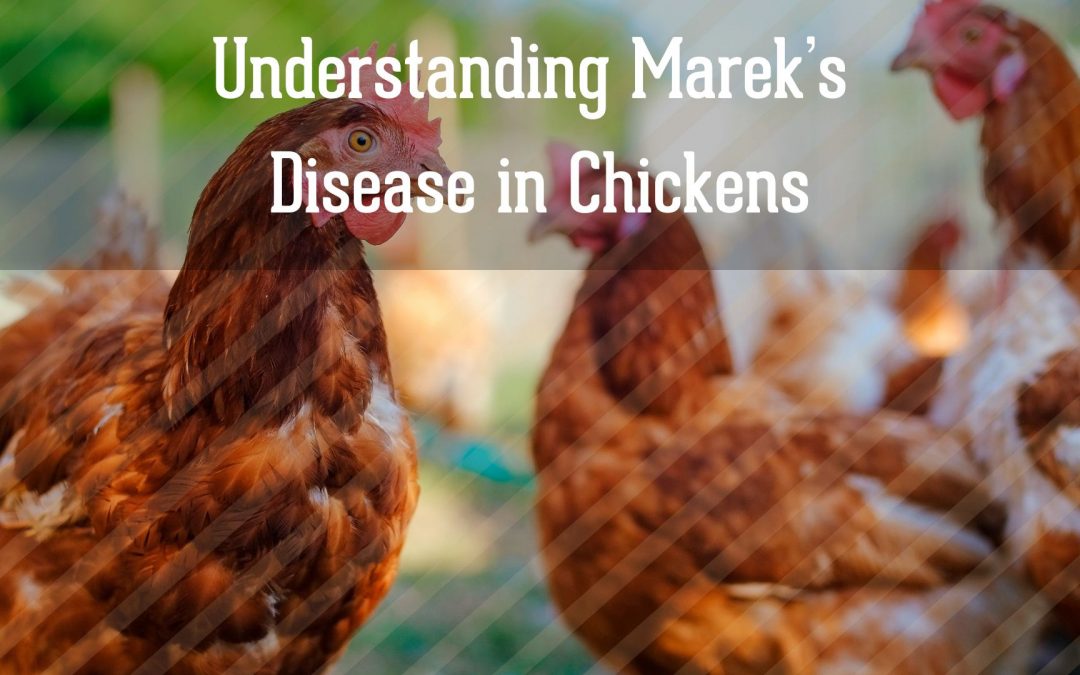Even if you’re new to chickens, the term Marek’s Disease is bound to pop up quickly in your journey into the world of poultry.
Your first experience with the term may have even been during checkout with your favorite online hatchery as an add-on optional vaccination.
So what is Marek’s disease in chickens and what do you need to know about it?
In short, Marek’s disease is a highly contagious viral infection that may cause death in chickens and, unfortunately, there is no cure.
Symptoms of Marek’s Disease in Chickens
Marek’s disease manifests in a couple different ways depending on the chicken and the strain of the virus. Some chickens will never show symptoms…even though they’re a carrier and may infect other chickens in your flock.
With that being said, some of the most common symptoms of Marek’s disease in chickens are:
- Chicks with legs braced far apart (or the splits)
- Grey or irregular-shaped pupils
- Inability to see
- Loss of condition
- Paralysis
While these are some of the most prominent symptoms of the disease, many birds perish due to secondary infections or due to weakness and pecking order problems.
Paralyzed chickens may be unable to defend themselves, or sustain themselves nutritionally, and death may follow.
Diagnosing Marek’s Disease
Since many of the symptoms seem obvious, it’s fairly easy to identify Marek’s disease. However, the only real way to diagnose the disease is to have a veterinarian examine the chicken either while it is alive or through a necropsy after it has passed away.
Treatment and Causes of Marek’s Disease in Chickens
Unfortunately, there is no cure for Marek’s disease, however, you can treat the symptoms and care for your chicken until it perishes.
Sometimes, chickens can live for a long time, depending on the symptoms, and simply removing it from the flock and allowing it to live out its days is the best option for a bird with mild symptoms.
With that being said, prevention is the best way to handle Marek’s disease so that it never becomes a problem in your flock.
Since Marek’s disease is passed from bird-to-bird through direct, or indirect, contact it can be difficult to rid your property of the disease once it’s present.
Chickens can contract Marek’s Disease through any of the following avenues:
- Chicken dander (from an infected bird)
- Wild birds
- Flock owners wearing contaminated clothing after caring for an infected flock
- Dander left in the coop from a previously infected flock
Preventing Marek’s Disease
The best way to prevent Marek’s disease is to only buy chickens from trusted hatcheries and breeders.
Researching the source of your flock-to-be is the number one way to ensure you’re getting healthy chickens, and not introducing the virus to your current flock (if you have one).
And when it comes time to add chickens to your flock, always purchasing from the same source, and opting to vaccinate your birds, are surefire ways to keep your flock healthy.
Because it’s not always possible to purchase chickens from the same source, a way to protect current avian residents is to quarantine new birds, or birds that have been off the property, for at least 30 days to ensure no symptoms develop.
Just remember, some birds never show symptoms, so it’s not always a foolproof way to protect your flock.
Lastly, if you’re out and about at the fair, or a neighbors coop, for example, it’s important to wash thoroughly and change your clothes and footwear before entering your coop in case the chickens you were in contact with were infected.
Deciding to Cull
It’s never fun to have a coop of chickens that are sick, but when it comes down to it, once Marek’s disease has infected your flock it can be difficult to identify which birds have been infected, and which are healthy.
If you’re able, you can start separating the sick birds or even have each of them tested for the disease, and create two different flocks (one healthy and one with Marek’s disease).
The alternative would be to cull the flock, clean the environment thoroughly, implement a waiting period to ensure the virus is gone, and start a new flock.
It’s not always ideal to cull an entire flock, as we come to love and depend on our chickens, but if some are suffering it may be in the flock’s best interest. Because it can be an extremely difficult disease to clear from your property, for the sake of future flocks, it may best to do your part to control the disease and cull sick birds.

